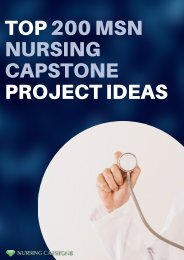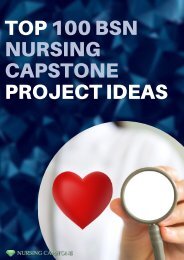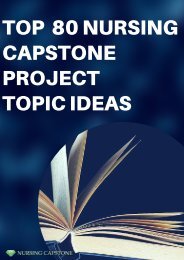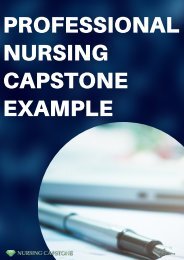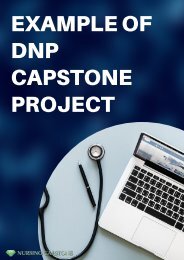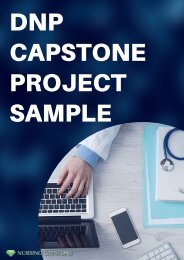Example of a MSN Capstone Paper
Hi! If you need to write a msn capstone paper, here is an example for you. For more useful examples go to https://www.nursingcapstone.net/msn-nursing-capstone-project-writing-expert-guide-to-follow/
Hi! If you need to write a msn capstone paper, here is an example for you. For more useful examples go to https://www.nursingcapstone.net/msn-nursing-capstone-project-writing-expert-guide-to-follow/
You also want an ePaper? Increase the reach of your titles
YUMPU automatically turns print PDFs into web optimized ePapers that Google loves.
<strong>MSN</strong> CAPSTONE<br />
PAPER<br />
EXAMPLE<br />
Words as a Medicine
At least once in a lifetime, a man finds himself in a situation that he has something to<br />
say but has no one to say to. A healthy man can even register something like that or<br />
quickly forget about it. A sick person has a need to talk about his illness <strong>of</strong>ten and to<br />
the smallest detail, because he is relieving him psychologically. In addition to the<br />
problems that have arisen - an impaired health, anxiety and worry-related illness - the<br />
encounter <strong>of</strong> misunderstanding or silence by a nurse and a doctor only complicates<br />
and complicates his already shaky condition. A sick person is very sensitive to such<br />
situations, he registers them quickly, memorizes, and this can leave a trace on his<br />
psyche in the form <strong>of</strong> a sense <strong>of</strong> neglect, a carelessness for his condition, feelings that<br />
he is in the wrong place where he does not want to help or that he is not help half or "in<br />
force". Every sick person needs expert help from a doctor and a nurse, and this includes<br />
talking, human contact, and feeling that he is not left to himself (Henderson, 2001). He<br />
needs a nice word - word like medicine. The doctor's word is <strong>of</strong>ten short, usually lasting<br />
as much as a physical examination. That is why the nurse is here to answer additional<br />
questions, to explain and explain even when she is not directly asked, and in the<br />
nonverbal signs he sees that the patient needs further information. When a patient is in<br />
the hospital, the nurse is the person with whom he is most <strong>of</strong>ten and the longest in<br />
contact. She is here for twenty-four hours, awake, follows, works and helps. Why not<br />
talk? Let's remember what our older ones would say: "A beautiful word and iron door<br />
opens.", As well as that: "A beautiful word <strong>of</strong> gold is worth it." The duty <strong>of</strong> a nurse is to<br />
provide the word with advice, instruction, information, to encourage patient patient's<br />
patience, all as an essential component <strong>of</strong> health care whose ultimate goal is to heal. It<br />
is important, <strong>of</strong> course, to show the best pr<strong>of</strong>essional knowledge, but also the warm<br />
hand and with it the mild word as an integral part. No - when it's a nice word like strong<br />
analgesics, it calms stronger than anxiolytic and raises mood as an antidepressant.<br />
Each <strong>of</strong> us has sometimes experienced long-sleeved patients with pain, worries and<br />
fears for their own health and the outcome <strong>of</strong> treatment. In such situations everything<br />
becomes darker and more unpredictable. The medication for all these patients'<br />
burdens is sometimes a nice word, which gives you a sense <strong>of</strong> security, a feeling that<br />
someone is there and worries about you (Peplau, 1992) The nurses beautiful word<br />
becomes the light at the end <strong>of</strong> the tunnel, a remedy that spreads fears and doubts. In<br />
order for a conversation to be clear for all patients, or unencumbered by terms in<br />
medical terminology, which a patient does not need to know, it would be a good thing<br />
for a nurse to learn through the education and learn how to use the terminology <strong>of</strong><br />
vocabulary, and by practice he chooses and build sisterly terminology that you will be<br />
able to use at the right time and in the right place. Thus communication would be
complete, pr<strong>of</strong>essional and useful for both participants. Any conversation that leads to<br />
the situation <strong>of</strong> an incomprehensible, time-extended and unreachable goal is speech in<br />
the empty, speech that costs.<br />
Fully established communication paves the way for everyday communication.<br />
The first appearance <strong>of</strong> the patient, his first arrival to the doctor, is usually the first<br />
contact between the patient and the nurse. For the patient, contact with a nurse is<br />
always the first contact with a healthcare worker in general. How this first kind <strong>of</strong><br />
communication is to take place on a sister-patient relationship is an important lesson<br />
that a nurse has to know and never forget. Every communication <strong>of</strong> a patient with a<br />
healthcare worker, and especially when it comes to first contact, is an important act for<br />
the patient. The first patient's contact can be self-initiated, i.e. the patient may come<br />
willingly, but may also be "under compulsion", i.e. persuaded by another person.<br />
Regardless <strong>of</strong> how the patient came in and for which the problem is sought by<br />
healthcare pr<strong>of</strong>essionals, the first report can start with some fear, anxiety, anger or<br />
some other difficulty by the patient. The mere fact that a patient does not feel well, i.e.<br />
that he is ill and that he came to seek help, carries a certain psychological weight in<br />
himself. The nurse is the one who creates, starts, leads and ends the first<br />
communication, well or with failures, depending on her expertise and communication<br />
skills (Timmins, 2007). The first contact <strong>of</strong> a nurse and patient should be warm,<br />
interactive, immediate, mild, pr<strong>of</strong>essional. The conversation should begin<br />
spontaneously, unhurriedly, patiently, without nervousness and watching the clock. A<br />
friendly, open and supportive atmosphere should be created. The patient must feel<br />
free and safe. It is necessary to speak in a language that the patient understands. If<br />
necessary, use pr<strong>of</strong>essional terminology, each term used is necessary to explain,<br />
because what is unknown will only confuse and scare the patient. The quality <strong>of</strong> the<br />
feedback is dependent on the quality <strong>of</strong> the question posed. In order to achieve this,<br />
the sisters must be clear about what kind <strong>of</strong> information they want to get from the<br />
patient. Questions should be short, concise, straightforward, clear and not burdensome<br />
as hard as first contact. If it is impossible to obtain a direct response from the patient<br />
because <strong>of</strong> a severe condition, i.e. with him to establish verbal communication, then the<br />
questions in the same way are directed towards the escort. In doing so, it is very<br />
important not to neglect and not to be trapped by the patient himself. Why? Because<br />
non-verbal signs, i.e. Non-verbal communication <strong>of</strong> the patient (e.g., facial cramp,<br />
blush,
oad pupils, facial redness, squinting, dull look, uncontrolled movements, etc.) signal<br />
things that the companion does not have to notice or consider them irrelevant for<br />
communication, indicating the patient's condition.<br />
Body language <strong>of</strong>ten tells us more than spoken. That's why every nurse would have to<br />
learn how to read it. The patient's face speaks, his eyes are asking and asking for an<br />
answer, his helpers help and when he did not say a single word. The nurse should be a<br />
"psychoanalyst without a degree," he must observe that silent speech, understand and<br />
interpret it correctly. What matters is that the sister-patient is in communication,<br />
positive word or gesture, the sisters must record somewhere and have a written clue <strong>of</strong><br />
their conclusions drawn from it. This can be registered in a workbook or a handout<br />
notebook. It would be optimal to make a syringe cardboard card, especially for each<br />
patient. Doctors have their history in the history <strong>of</strong> the disease, their symptoms, their<br />
temperature lists. Why not the sisters? It would be a summary <strong>of</strong> everything that<br />
happens with and around the patient, and is related to its scope <strong>of</strong> work<br />
REFERENCES<br />
Timmins, F. (2007). Communication skills: revisiting the fundamentals. Nurse<br />
Prescribing, 5, 395 - 9.<br />
Henderson, A. (2001). Emotional labor and nursing: An underappreciated aspect <strong>of</strong><br />
caring work. Nursing inquiry 8 (2), 130 – 138.<br />
Peplau, H. (1992). Interpersonal relations: A theoretical framework for application in<br />
practice. Nursing Science Quarterly, 5 (1), 13 – 18.





